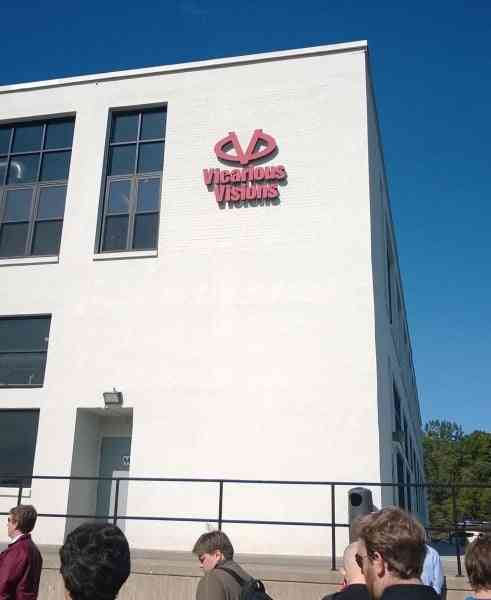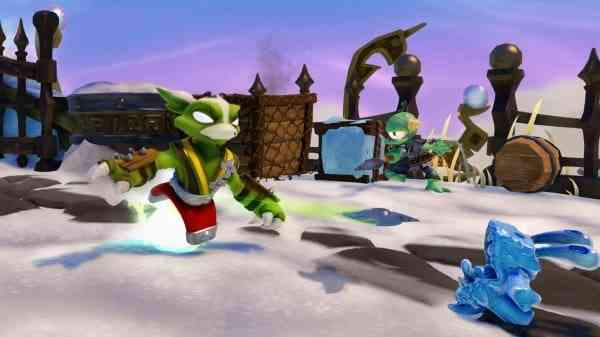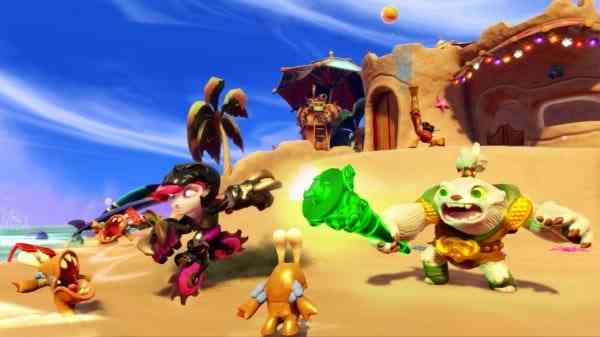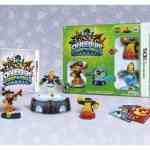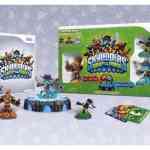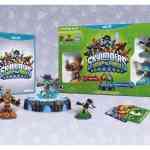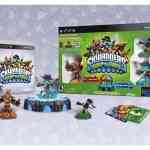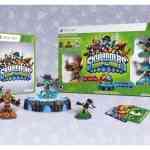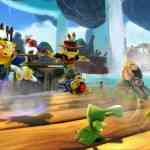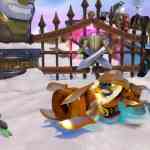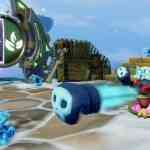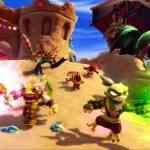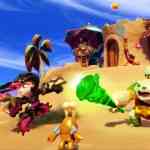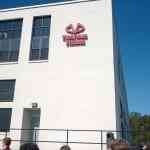If you follow any of our ramblings here on COG then you know that I wrote an article about a week and a half or so ago documenting the first part of my visit to Vicarious Visions, developer for Skylanders SWAP Force, as I got a “behind the scenes” look at development for this incredibly popular family friendly franchise. In that first part, which you can read HERE, I focused on the areas of how the game’s concept was conceived, how they developed the swappable figurines, and how moves and combat are developed too. This was only part of what I saw during the full day visit, so I am back to share the second and final part of what I saw and what I learned.
Personally, one of the unsung heroes in many of the games I play are the sound designers. I always pay close attention to a game’s sounds, from the way a character walks or talks to the way a character sounds in any environment. Of course we can’t forget the music either. When all these elements are combined they can definitely create a more immersive experience.
The sound designer we spoke too (sorry, his name escapes me and it wasn’t in my notes) is a big fan of many of the Skylander characters that have been developed over the years. He focused on Fryno, the new character I spoke about in part one of my write up. He told us that all of the sounds for Fryno, along with all the other Skylanders, are made of a combination of different sounds layered together. From jumping to running there is a combination of sounds put together to form each specific sound you hear.
Character moves are laid out for the sound designers to figure what the appropriate sounds should be. It’s not a simple process and they work with the animators to learn more about each character such as if they walk heavy or light or what they use to move around (e.g. legs, wheels, tentacles, etc.). They then take the video form of each character, sync up the newly created sounds, fine tune them, and then finalize what sounds will represent each move or action of each character. As we watched the demo of Fryno we were shown that something as simple as his jump and landing was a mix of four separate tracks layered together to form the one sound we heard. Each Skylander has 80 different sounds and they are suited to each personality of each character. You do the math.
I was curious to see if they had added anything to the generation one characters (those from Spyro’s Adventure). They didn’t change anything outright but they “sweetened” the sounds as they made them brighter and able to fit in with SWAP Force characters and universe; they basically “uprezzed” them so to speak. They did have to add new sounds for each characters new jump mechanic though as the legacy characters, as well as those from Skylanders Giants, didn’t jump in previous games, and when doing this they had to stay true to the source. Staying true to each character from when they were first introduced did prove to be a daunting task, but they managed it.
One of the neat things we were shown was the environmental effects found throughout the game. Many gamers don’t notice such things like this. We saw on screen, and heard through the speakers, how different environments made different sounds. Such things as walking on wood, ice, grass, dirt, metal, and in water were distinctly different when Fryno walked on each surface. Seeing it happen in real time, and realizing that you have multiple characters walking on it at the same time in game, gives you have a new appreciation for this kind of stuff.
One neat tidbit we learned during the demo was how the suction cup sound of Wash Buckler’s tentacles was designed. The team didn’t know how to approach this, and then one day a sound designer had an idea to use one of those bathmats with suction cups. They immediately went to one of the audio designer’s bathrooms with a hand recorder that they all carry and they put the bathmat in the bathtub and recorded the sound of the mat being put down and pulled up while the suction cups did their thing (attaching to tub, unattaching from tub).
We also learned that the sound team used many different types of instruments for the music in such that they don’t stick to only “American” types of instruments, as they don’t want the game to just have an “American” feel to it. They use instruments that have a wide international flair, not only so those playing all over the world can hear instruments specific to their country, but the music has a worldwide feel that all those who play will appreciate. It’s little things like this that are amazing.
During the day we also got to sit in on a session with the rendering team. One of the ambitious goals that they had was to allow those who play SWAP Force to feel like they were truly playing an interactive animated movie. They use a lot of technology that is commonly used when making an FPS game or tech that is used when making a high intensity graphics game. It was kind of neat to learn that a family oriented franchise was using such advanced tech found in games that are not even remotely linked to it.
The relationship between concept artists and the rendering team is very important. A prime example is that we were shown was some conceptual art of a piece of environment had water around it. The rendering team took specific swatches, such as shallow water, murky water, etc., and then created in-game visuals that demonstrated it was possible to do in-game what the concept artists envisioned through sketches. They then took the water demos and turned it into ice, and this art and rendering was the foundation of the level Winter Keep. The key here is that the relationship between the concept artists and the rendering team was such that the artists saw what could be done with the in-game graphics engine, and they could then create levels that were indeed doable using the tech to make the game. If the concept artists didn’t know that what the rendering team could do they wouldn’t have been able to let their creativity shine to the level it did.
A really neat thing that we were shown during our time the rendering session was the “on-the-fly” tools that they used during development showing us how they could envision things in real time. Watching the rendering team use their PC Tools in real-time not only made me realize what they were able to do with the visuals, but how much work they put into this aspect. Although the game engine is geared for next-gen consoles, the engine does scale back to allow for a good-looking game on the current generation of machines. There is some loss of detail, such as parallax inclusion mapping, but given the horsepower available with the Xbox 360, PS3, Wii U and Wii, this is to be expected. Looking at the visuals with this feature on (next-gen) and off (current gen) you can indeed see the difference, and if anything when the feature is on you see how the team is getting to that “interactive animated feature” look. Being able to see the differences of the game on the fly was pretty neat, and regardless of what platform you play it on, the scalability of the game’s graphic engine is impressive allowing it to look darn good on the current generation of machines.
As with the many other areas that I was becoming educated in regarding the range of work that goes on when making SWAP Force, one final surprise for me came in the form of the cinematics area. Holy cow, I don’t think I was prepared to see what they did indeed do in this area. One of their main goals in regards to the cinematics was to communicate the story of SWAP Force to gamers in a manner that fans were already familiar with. One of the other main goals was that they wanted people to feel like they were part of a big budget animated feature that both kids and adults are familiar with. To do this they wanted to create a seamless experience moving from cinematics to gameplay. This is accomplished using the in-game engine and rendering them using the same assets that are used in the games actual levels.
One of the interesting things we learned was how they set up the story that was to be told. They start with goals (e.g. introduce characters, mission parameters, and what they were trying to set up), then make up some storyboards, then they do some conceptual shots showing what would work in regards to “film” angles, they then do the voice work, and once agreeing upon everything then they do the final piece. What struck me was that this kind of work seemed to be the same as an actual animated feature (what can I say, I watch the special features on many of my Blu-rays). It’s somewhat staggering to know that they have done this for the whole 24 minutes of “major” cinematics they have. Between the in-game rendered cinematics and pre-rendered cinematics there are over 40 minutes of this type of work. I feel they could have just done a full movie if they wanted too.
When they showed how all the steps for one particular scene are combined, and the final cinematic that was used in game, the visuals were pretty impressive, and knowing that they were using the in-game engine assets made it even more notable. The scene they showed used the current-generation tools (Xbox 360) and this surprised me given the level of detail that was implemented. This was very evident as the environment was a winter/snow-based level and you could see the breath from each character in the cold air as they spoke. To take advantage of such little details is pretty amazing and adds to the immersion of cinematics.
If there is one thing I definitely learned during my time at Vicarious Visions, it was that there is a heck of a lot more work that goes into SWAP Force then I ever envisioned. Don’t get me wrong, it’s not like I thought they weren’t working, but after sitting with each discipline and hearing what they do and how they do it, I literally have a whole new appreciation for what goes into this game. A big thanks for Activision for bringing us to Vicarious Visions for the behind the scenes look, and a big thank you to Vicarious Visions for letting me personally see all the hard work, and magic, that has gone into making SWAP Force. We hope you enjoyed our inside look at how the next iteration of the Skylanders franchise is made, personally I had a great time learning what they do and I am glad I could share it with you.
